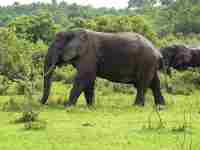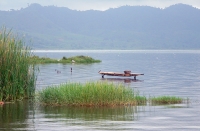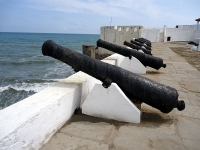Country guides

Things to do in Ghana
Ghana is a beautiful country, often affectionately called 'Africa for Beginners' because of its friendly locals and comparative stability and prosperity. It is the ideal destination for first-time travellers in Africa. However, this does not mean that travel in Ghana is always without complication, particularly as the tourist infrastructure is only well developed in certain popular areas.
Visitors tend to spend their time in the capital city, Accra, the historic royal stronghold of Kumasi (traditional home of the Ashanti people), and in various picturesque coastal villages. One of the best ways to enjoy Ghana is to explore the coastline, which boasts both incredible tropical beaches and a number of historic colonial forts, many of which are UNESCO-listed.
There are two alluring National Parks in the country, where visitors can seek out Ghana's wealth of wildlife. Kakum National Park is a rainforest reserve with some amazing canopy walkways suspended above the forest, while Mole National Park is a massive wildlife reserve, consisting mainly of savanna, and containing more than 90 mammal species.
Visitors should note that in the rainy season, between April and October, many roads in Ghana become so muddy and flooded that they are impossible to traverse, making some attractions, such as the national parks, very difficult to access.

Mole National Park
Located in the northwest of the country, Mole National Park is Ghana's largest reserve and a tremendous treat for nature lovers. The terrain is mostly flat savanna, which is ideal …
Mole National Park
Located in the northwest of the country, Mole National Park is Ghana's largest reserve and a tremendous treat for nature lovers. The terrain is mostly flat savanna, which is ideal for spotting wildlife. Visitors are likely to see baboons, hippos, monkeys, warthogs, buffalos, crocodiles, elephants and assorted antelope, among other animals. Indeed, the park is home to more than 90 mammal species. Predator sightings are more rare, though visitors may encounter hyenas, leopards and lions. Travellers should note that the park's infrastructure has never been developed for tourism, and they should not expect much in the way of amenities. The best time to visit is in the dry season (November and April), when roads are dry and drivable, and wildlife is easier to find.

Kumasi
Kumasi is the traditional home of the Ashanti people, and is a rich cultural centre. Some call it 'The Garden City', in recognition of its diverse flora. Historically speaking, thi…
Kumasi
Kumasi is the traditional home of the Ashanti people, and is a rich cultural centre. Some call it 'The Garden City', in recognition of its diverse flora. Historically speaking, this old and proud African city rose to prominence in 1695, taking on the British in several Anglo-Ashanti wars. It has an active king to this day. Travellers will find many cultural and historical attractions and landmarks in the city and some great traditional markets to explore. The Manhyia Palace is a good first stop. Built in 1925, it was used as a royal Ashanti residence until 1974 and now houses an interesting museum. It still contains the original furnishings and a collection of royal artefacts.

The Ghanaian Coast
Ghana is blessed with hundreds of miles of pristine coastline and the country's beaches are among its greatest attractions. Some of the best beaches can be found at Busua and Dixco…
The Ghanaian Coast
Ghana is blessed with hundreds of miles of pristine coastline and the country's beaches are among its greatest attractions. Some of the best beaches can be found at Busua and Dixcove, two rustic fishing villages conveniently close to Accra. The beaches are long and sandy, great for walking and swimming and sometimes even suitable for some decent surfing. The Ghanaian coastline is also notable for the historic colonial forts that dot its shores. They're reminders of the region's onetime importance as an outpost in the slave trade. Nowhere is this more evident than in the former British colonial capital of Cape Coast, a now flourishing modern town that was once the largest slave-trading centre in West Africa.


